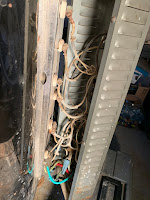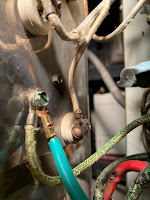Ask Arnold
Howard Kiln Services
Kiln Academy
Kiln Dead Short
Kiln Oven
Kiln Safety
Kiln Technicians
maintenance
Paragon A-24B
Paragon Kilns
Thermocouple
Hunting for a Dead Short in a Kiln
 This post was written by Arnold Howard, a former employee at Paragon Industries who is now an independent kiln technician at Howard Kiln Services.
This post was written by Arnold Howard, a former employee at Paragon Industries who is now an independent kiln technician at Howard Kiln Services. The owner of a Paragon A-24B called to tell me he saw sparks flash inside the switch box on his kiln, and the circuit breaker tripped. He could see the flash through the ventilation louvers on the side of the box. “It made a loud noise that scared the hell out of me,” he said. “It happened when I turned the bottom switch to high.”
“Your kiln has a dead short,” I told him. A dead short causes a large amount of electricity to flow suddenly through the wires. This shuts off the circuit breaker for your kiln because the surge of electricity is much greater than the amperage rating of the circuit breaker. A dead short usually happens when the protective insulation on a wire has been damaged, and the bare wire touches either another wire, an element connector, or the steel case of the kiln.
After arriving at the customer's home, the first thing I did was open the switch box by removing hex-head screws with a 1/4” nut driver. The screws are on the sides of the switch box of most kilns. You can buy the 1/4” nut driver from a hardware store. Some brands of kilns require a different size nut driver. If the size you need is not available locally, you can order one online. This may be the case overseas as the 1/4” size is uncommon there.
Remember, always BE SAFE! If you ever remove the switch box on your kiln, first unplug the kiln. This is essential because otherwise you will be exposed to live wires inside the opened box.
In the first photo, you can see the element connectors, which are small brass barrels with a screw-on each end. Notice that a wire is attached to each connector. In the A-24B, those wires go to switches. In digital kilns, the wires go to relays, which turn the elements on and off.
Lying on the garage floor, under the shadow of my lamplight, I hunted for the dead short. Since the sparks flashed when the bottom switch was turned to high, I started my search at the bottom of the switch box.
In the second photo, you can see where the short occurred. Look at the element connector in the bottom center half of the photo. It is the blackened brass barrel that is against a white porcelain insulator. The element connectors are the hottest items in the switch box. If a wire touches an element connector, the insulation on the wire can eventually burn off and cause a dead short.
In the bottom right corner of the photo is a red wire with a burned spot. That burned spot is where the wire touched the element connector. The spark blackened the connector.
With any routine kiln maintenance, you or your kiln technician will need to open the switch box or protective cover panel on your kiln if you ever change a thermocouple, relay, switch, or repair a damaged wire. As you can see from the photos, it is important that as you reinstall the switch box or panel onto the kiln, check that the wires will not touch an element connector.
To be sure that the wires would not touch element connectors or the kiln case, I looked at the wires from the side while closing the switch box, tucking some of the wires out of the way inside the box. Then I carefully positioned the switch box on the kiln and installed the screws. You might want to shine a flashlight into ventilation slots or louvers to check the position of the wires one last time after you have reinstalled the switch box.
As you can see from this story, major kiln problems can be avoided by taking just a moment to check the small details whenever anyone works on your kiln.
Thanks, Arnold!









Leave a comment